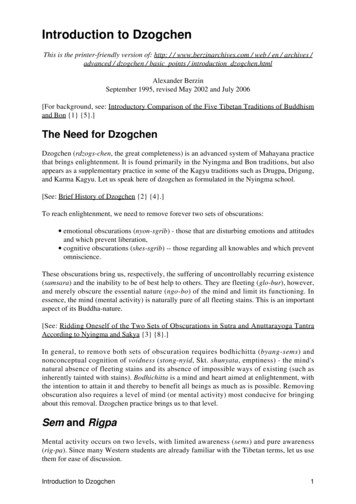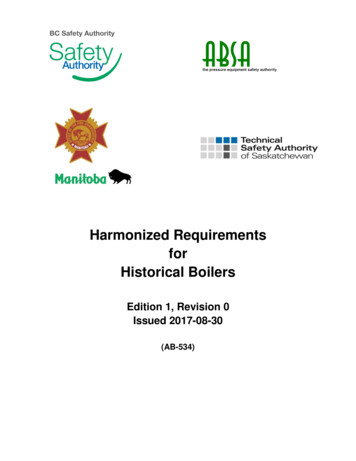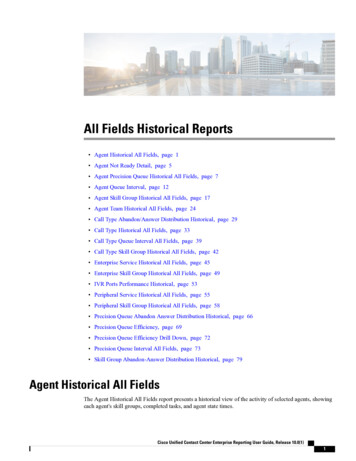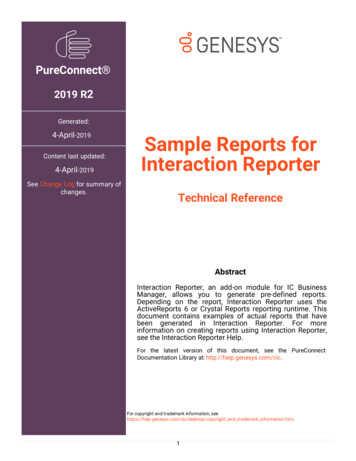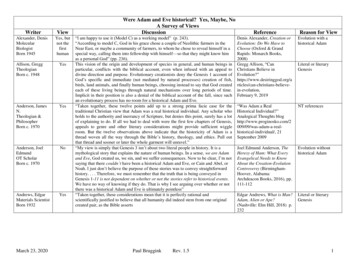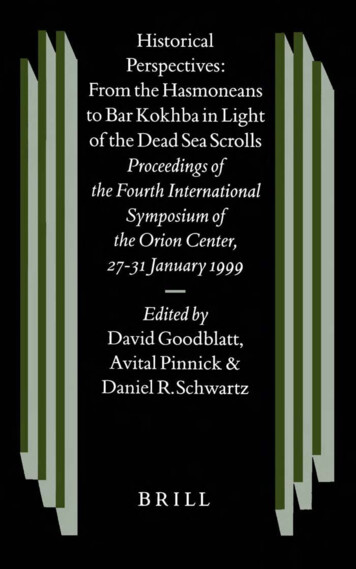
Transcription
HISTORICAL PERSPECTIVES:FROM THE HASMONEANS TO BAR KOKHBAIN LIGHT OF THE DEAD SEA SCROLLS
STUDIES ON THE TEXTSOF THE DESERT OF JUDAHEDITED BYF. GARCIA MARTINEZA. S. VAN DER WOUDEASSOCIATE EDITORP.W. FLINTVOLUME XXXVII
HISTORICAL PERSPECTIVES:FROM THE HASMONEANSTO BAR KOKHBA IN LIGHT OFTHE DEAD SEA SCROLLSProceedings of the Fourth International Symposiumof the Orion Centerfor the Study of the Dead SeaScrolls and Associated Literature, 27-31 January, 1999EDITED BYDAVID GOODBLATTAVITAL PINNICK&DANIEL R. SCHWARTZBRILLLEIDEN BOSTON KOLN2001
This book is printed on acid-free paper.Die Deutsche Bibliothek — CIP-EinheitsaufnahmeHistorical perspectives: from the Hasmoneans to Bar Kokhba in light ofthe Dead Sea Scrolls : 27 - 31 January, 1999 / ed. by David Goodblatt. - Leiden ; Boston ; Koln : Brill, 2000(Proceedings of the Fourth International Symposium of the Orion Center forthe Study of the Dead Sea Scrolls and Associated Literature ; 4)(Studies on the texts of the desert of judah ; Vol. 37)ISBN 90-04-12007-6Library of Congress Cataloging-in-Publication DataLibrary of Congress Cataloging-in-Publication Data is also available.ISSN 0169-9962ISBN 90 04 12007 6 Copyright 2001 by Koninklijke Brill NV, Leiden, The NetherlandsAll rights reserved. No part of this publication may be reproduced, translated, stored ina retrieval system, or transmitted in any form or by any means, electronic,mechanical, photocopying, recording or otherwise, without prior writtenpermission from the publisher.Authorization to photocopy itemsfor internal or personaluse is granted by Brill provided thatthe appropriate fees are paid directly to The CopyrightClearance Center, 222 Rosewood Drive, Suite 910DanversMA01923, USA.Fees are subject to change.PRINTED IN THE NETHERLANDS
CONTENTSPrefaceviiAbbreviationsixHISTORY OF THE JEWS AND JUDAISMJudean Nationalism in the Light of the Dead Sea Scrolls .DAVID GOODBLATT3The Kittim in the War Scroll and in the PesharimHANAN ESHEL29Antiochus IV Epiphanes in JerusalemDANIEL R. SCHWARTZ45Shelamzion in Qumran: New InsightsTAL ILAN57Descriptions of the Jerusalem Temple in Josephus andthe Temple ScrollLAWRENCE H. SCHIFFMAN69COMMUNITY AND COVENANTThe Concept of the Covenant in Qumran Literature85BlLHAH NlTZAN"[T]he[y] Did Not Read in the Sealed Book": QumranHalakhic Revolution and the Emergence of Torah Studyin Second Temple JudaismADIEL SCHREMERCommunal Fasts in the Judean Desert ScrollsNOAH HACHAM105127
V1CONTENTSThe Community of Goods among the First Christiansand among the EssenesJUSTIN TAYLOR147NATURAL SCIENCES AND THE SCROLLSThe Genetic Signature of the Dead Sea ScrollsGILA KAHILA BAR-GAL, CHARLES GREENBLATT,SCOTT R. WOODWARD, MAGEN BROSHI, AND PATRICIA SMITHAnalysis of Microscopic Material and the Stitching of theDead Sea Scrolls: A Preliminary StudyAZRIEL GORSKIHow Neutron Activation Analysis Can Assist Researchinto the Provenance of the Pottery at Qumran165173179JAN GUNNEWEG AND MARTA BALLAIndex of Modern AuthorsIndex of Ancient Sources187191
PREFACEAfter the first three Orion conferences were dedicated to more ethereal topics of Qumran scholarship (biblical interpretation, the pseudepigrapha, and the Damascus Document), the topic of the fourth annualsymposium, "Jewish History from the Maccabees to Bar Kochba,"was meant as a gesture to the real world, an attempt to move tomore tangible things. This plan was seconded by the decision toinclude in the conference, and hence in this volume of proceedings,some studies of the most tangible elements that have come out ofQumran: animal skins, the threads used to sew them into scrolls,and pottery.In practice, however, it turned out that the attempt to distinguishbetween flesh and spirit was not successful, and that no one was disappointed by that failure. Things of the spirit do have their real history, and Qumran texts do not talk history without the spirit. Thus,one way or another, people kept leading us back to texts and ideas,and texts and ideas kept leading us back to people. So, on the onehand, David Goodblatt's study of Qumran evidence for ancient Jewishnationalism turns out to be bound up, part and parcel, with theimportance of the Bible at Qumran, no less than Adiel Schremer'scontribution, which began with the status of books there. Similarly,Hanan Eshel's study of the Kittim (were they Greeks? Romans?) andTal Ilan's search for Qumran allusions to Salome Alexandra resultin studies of how the Qumran community read the Bible. EvenLawrence Schiffman's paper on the description of the Temple andDaniel Schwartz's on Antiochus Epiphanes move back and forthincessantly between "historical sources" and the Bible via Qumran eyes.On the other hand, Bilhah Nitzan's study of the covenant atQumran and Noah Hacham's examination of communal fasts arefar from studies of timeless doctrines. They are bound up with thefabric and realities of a flesh and blood religious community. Thesame may be said of Justin Taylor's paper, which, on the face of it,attempts to resolve textual and exegetical inconsistencies in the Bookof Acts, but in fact ends up by positing some real differences amongvarious communal groups.The three remaining studies, whose citation style follows the format
viiiPREFACEcustomary in the natural sciences, derive from the work of theJerusalem Task Force for Science and the Scrolls, a group of scholars (organized by the Orion Center and the Hebrew University/Hadassah Medical School's Kuvin Center for Infectious and TropicalDiseases) dedicated to the enrichment of Qumran studies by theapplication to the Scrolls and related materials of methods of analysis from the world of the natural sciences. While carbon 14 datingof the Scrolls is more or less old hat, the studies presented here showthat the natural sciences have much more to offer us: such methods as neutron activation analysis of pottery (Jan Gunneweg andMarta Balla), analysis of the DNA of the skins upon which the Scrollswere written (Gila Kahila Bar-Gal et al.), and forensic techniques(Azriel Gorski) can supply hard data concerning some of the parameters within which our research must focus. The Orion Center isproud to play a role in the fostering of such fruitful cooperationamong the disciplines.The Fourth Orion Symposium was made possible by the kind andgenerous funding of the Orion Foundation and the Hebrew Universityof Jerusalem. We sincerely thank them, as well as all the dedicatedcollaborators of the Orion Center whose devoted work makes thisseries a reality.David GoodblattLa folla, CaliforniaAvital PinnickDaniel R. SchwartzJerusalemJuly 2000
ABBREVIATIONSABAnchor BibleANRWBARAufstieg und Niedergang der Romischen WeltBiblical Archaeology CIEJJBLJJSJQRJSJBibliotheca Ephemeridum Theologicarum LovaniensiumBrown Judaic StudiesCatholic Biblical QuarterlyCatholic Biblical Quarterly Monograph SeriesCompendium Rerum Iudaicarum ad Novum TestamentumDiscoveries in the Judaean DesertDiscoveries in the Judaean Desert of JordanDead Sea DiscoveriesEncyclopaedia JudaicaHarvard Semitic StudiesHarvard Theological ReviewHebrew Union College AnnualInternational Critical CommentaryIsrael Exploration JournalJournal of Biblical LiteratureJournal of Jewish StudiesJewish Quarterly ReviewJournal for the Study of Judaism in the Persian, Hellenistic andRoman PeriodJSJSupJournal for the Study of Judaism Supplement SeriesJSNTJournal for the Study of the New TestamentJSOTJournal for the Study of the Old TestamentJSOTSup Journal for the Study of the Old Testament SupplementSeriesJSPSupJournal for the Study of the Pseudepigrapha SupplementSeriesNTSNew Testament StudiesNTSupNovum Testamentum Supplement SeriesPAAJRPEQRBREJProceedings of the American Academy for Jewish ResearchPalestine Exploration QuarterlyRevue BibliqueRevue des Etudes Juives
ABBREVIATIONSXRevQRevue de QumranSBLMS Society of Biblical Literature Monograph SeriesSBLRBS Society of Biblical Literature. Resources for Biblical StudySBLSymSCISFSHJSRSociety of Biblical Literature Symposium SeriesSJLASTDJTSAJTWATVTZAWStudies in Judaism in Late AntiquityStudies in the Texts of the Desert of JudahTexte und Studien zum Antiken JudentumZNWScripta Classica IsraelicaSouth Florida Studies in the History of JudaismStudies in Religion/ Sciences religieusesTheologisches Worterbuch zum Alten TestamentVetus TestamentumZeitschrift fur die alttestamentliche WissenschaftZeitschrift fur die neutestamentliche Wissenschqft
HISTORY OF THE JEWS AND JUDAISM
This page intentionally left blank
JUDEAN NATIONALISM IN THE LIGHT OFTHE DEAD SEA SCROLLSDAVID GOODBLATTUniversity of California, San DiegoAs someone whose professional research interests have always includedthe Second Temple period, I applaud the Orion Center for theirchoice of topic for this symposium, Jewish History from the Maccabeesto Bar Kokhba in Light of the Dead Sea Scrolls, because it encourages adialogue between Qumran studies and the study of the history ofJudea during late Second Temple times. Such a dialogue has beenall too rare during the first half century of study of the scrolls. Notthat Second Temple history was absent from Qumran studies but itwas invoked only as background and context. Qumran scholars lookedto Second Temple history in their attempts to identify the groupwhich produced (at least some of) the scrolls. They used that history to identify the (very few) historical personages mentioned byname in the texts, and to suggest possibilities for uncovering the persons hiding behind such sobriquets as the Wicked Priest and theWrathful Lion.1 What was relatively lacking was the reverse: usingthe Dead Sea Scrolls to illuminate the history of the Jews. This lackmeant that there was relatively little mutual dialogue. One exception concerns the period between the death of Alcimus in about 160BCE and the appointment of Jonathan as high priest in 152 BCE.Several scholars have used Qumran materials in an attempt to reconstruct what happened in Jerusalem during these years.2 However, it1For the few historical personages mentioned by name, see M. Broshi, "Ptolasand the Archelaus Massacre (4Q468g 4Qhistorical text B)," JJS 49 (1998): 342-43.The identification of the pwt ys mentioned in this text as Ptolas, on pp. 343—45,has been contested by J. Strugnell, "The Historical Background to 4Q468g [ 4Qhistoricaltext B]," RevQ73 (1999): 137-38; D. R. Schwartz, "4Q468g: Ptollas?" JJS 50 (1999):308-9; and W. Horbury, "The Proper Name in 4Q468g: Peitholaus?" JJS 50 (1999):310-11.2I refer to those advocates of the 'Maccabean Hypothesis' of Qumran originswho suggested that Jonathan was the Wicked Priest while the Teacher of Righteousnessmay have been the high priest who succeeded Alcimus. This group includes G. Vermes,J. T. Milik, G. Jeremias, H. Stegemann, and J. Murphy-O'Connor. See the literature
4DAVID GOODBLATTis hard to think of other examples. There are also instances of scholars who contribute both to Qumran studies and to the history ofSecond Temple Judea and one would hesitate to say there wasabsolutely no overlap between their work on these two subjects. Still,we are dealing with exceptions and not the rule.That the first half century of Qumran studies has had limitedimpact on the historiography of Second Temple Judea can be illustrated in various ways. Let us begin by looking at the revised edition of Fitzmyer's The Dead Sea Scrolls, which gives us a sense of thestate of the field in 1990. Chapter Ten, a "Select Bibliography onSome Topics of Dead Sea Scrolls Study," contains ten topics, including archaeology, the Bible and biblical interpretation, theology, messianism, the New Testament, the calendar, and the history of theQumran community. The history of Judea or of the Jews, however,is not one of the topics. The situation did not change during the1990s, as a perusal of more current scholarship will indicate. I beginwith three recently published introductions to Qumran studies.Vanderkam's The Dead Sea Scrolls Today has the following chapters:"Discoveries," "Survey of the Manuscripts," "The Identification ofthe Qumran Group," "The Qumran Essenes," "The Scrolls and theOld Testament," "The Scrolls and the New Testament," and "Controversies about the Dead Sea Scrolls." Cross, in his revised versionof The Ancient Library of Qumran, has these chapters: "Discovery of anAncient Library," "The Essenes, the People of the Scrolls," "TheRighteous Teacher and Essene Origins," "The Old Testament atQumran," and "The Essenes and the Primitive Church." The chapters in Jonathan Campbell's Deciphering the Dead Sea Scrolls are titled"What Are the Dead Sea Scrolls?," "The Dead Sea Scrolls and theBible," "Who Wrote the Dead Sea Scrolls?," "The Dead Sea Scrollsand Judaism," "Christianity Reconsidered," and "Controversy andConspiracy." No one has a chapter on the Scrolls and the historyof the Jews or of Judea.3cited by P. R. Callaway, The History of the Qumran Community. An Investigation (Sheffield:JSOT Press, 1988), 212 n. 5, and 15-19, for a summary statement of the positionsof the three last-named members of this school of thought.3J. A. Fitzmyer, The Dead Sea Scrolls. Major Publications and Tools for Study, rev. ed.,SBLRBS 20 (Atlanta: Scholars Press, 1990); J. C. VanderKam, The Dead Sea ScrollsToday (Grand Rapids: Eerdmans, 1994); F. M. Cross, Jr., The Ancient Library ofQumran, 3rd ed. (Minneapolis: Fortress, 1995); J. G. Campbell, Deciphering the DeadSea Scrolls (London: Fontana, 1996).
JUDEAN NATIONALISM5The absence of Jewish and Judean history characterizes not onlythese introductory surveys but also studies representing the cuttingedge of Qumran research. Let us examine three symposia held during this decade. The papers presented at the 1992 conference sponsored by the New York Academy of Sciences were grouped forpublication under the following five headings: Archaeology and Historyof the Khirbet Qumran Site; Studies on Texts, Methodologies andNew Perspectives; The Scrolls in the Context of Early Judaism; Books,Language and History; and Texts and the Origins of the Scrolls.The history alluded to in the title of the fourth section is exhaustedby a study of whether the list of treasures in the Copper Scroll isfactual. The 1993 Notre Dame symposium organized its papers underthe following rubrics: The Identity of the Community; The Communityand Its Religious Law; The Scriptures at Qumran; Wisdom andPrayer; and Apocalypticism, Messianism, and Eschatology. Finally,to return to our present venue, the symposium sponsored by theOrion Center in 1996 was explicitly devoted to the use and interpretation of the Bible.4 In view of this trend, it is not surprising tofind the following in the foreword to a "study edition" of the DeadSea Scrolls. The editors mention that their work is intended, interalia., for scholars who do not specialize in Qumran studies. Thus,they hope that their work will be useful for those who work on theHebrew Bible, the New Testament, rabbinic literature, Semitic languages, the History of Judaism, or the History of Religions. Conspicuousby its absence from this list of specialities is the history of Judea orof the Jews.5What is implicit in the evidence just cited is made explicit byVermes. He writes, "Looking at the Qumran discoveries from anoverall perspective, it is—I believe—the student of the history ofPalestinian Judaism in the intertestamental era (150 BCE-70 CE)4Methods of Investigation of the Dead Sea Scrolls and the Khirbet Qumran Site: PresentRealities and Future Prospects, ed. M. O. Wise, N. Golb, J. J. Collins, and D. G.Pardee, Annals of the New York Academy of Sciences 722 (New York: New YorkAcademy of Sciences, 1994); The Community of the Renewed Covenant: The Notre DameSymposium on the Dead Sea Scrolls, ed. E. Ulrich and J. C. Vanderkam (Notre Dame:University of Notre Dame Press, 1994); Biblical Perspectives: Early Use and Interpretationof the Bible in Light of the Dead Sea Scrolls. Proceedings of the First International Symposiumof the Orion Center for the Study of the Dead Sea Scrolls and Associated Literature, 12—14 May1996, ed. M. E. Stone and E. G. Chazon, STDJ 28 (Leiden: Brill, 1998).5F. Garcia Martinez and E. J. C. Tigchelaar, ed., The Dead Sea Scrolls StudyEdition, vol. 1 (Leiden: Brill, 1997-98), ix.
6DAVID GOODBLATTwho is the principle beneficiary." Conversely, "The contribution ofthe Scrolls to general Jewish history [emphasis in original] is negligible. . . ." Vermes continues immediately with an explanation: "Thechief reason for this is that none of the non-biblical compositionsfound at Qumran belong to the historical genre."6 No doubt thisfact constitutes a large part of the explanation. Certainly those whofocus on political or diplomatic history will find little of immediateinterest in the Qumran materials. The near or total absence of documentary texts from Qumran also deterred historians.7 Perhaps thefact that we are dealing with a relatively out-of-the-way site peopledby as few as sixty individuals was another deterrent to study by historians of Judea.8 Further, the biblical, parabiblical and religiouscharacter of the manuscripts attracted students whose interests laymuch more in the history of Judaism than in Jewish history. Thebackground of both the original group of editors and the currentgroup is overwhelmingly in religion, including Bible, Apocrypha and,more recently, rabbinics.There may be yet another factor that made historians hesitate toexploit the Qumran scrolls. Until recently much of the material wasunavailable to those outside the circle of scholars with access to themanuscripts. Drawing conclusions from the texts already in the public domain carried with it the danger of relying on only part of thetestimony. To be sure, any conclusion can be overtaken by subsequently discovered evidence but in the case of Qumran the danger6G. Vermes, The Complete Dead Sea Scrolls in English (New York: Allen Lane, 1997),24, 17, respectively.7Ada Yardeni argues that the non-literary texts attributed to Qumran and labeled4Q342-348, 4Q351-354 and 4Q356-361 are more likely part of the Wadi Seiyalcollection. See H. M. Cotton and A. Yardeni, ed., Aramaic, Hebrew, and Greek DocumentaryTexts from Nahal Hever and Other Sites, DJD 27 (Oxford: Clarendon Press, 1997), 283.On the other hand, some documentary material has been uncovered at Qumran.See F. M. Cross and E. Eshel, "Ostraca from Khirbet Qumran," IEJ 47 (1997):17—28. As to historiographic works, see M. O. Wise, "Primo Annales Fuere: AnAnnalistic Calendar from Qumran," in his Thunder in Gemini (Sheffield: JSOT Press,1994), 186-221; M. Broshi and E. Eshel, "The Greek King Is Antiochus IV(4QHistorical Text 4Q248)," JJS 48 (1997): 120-29; and 4Q578, published byE. Puech, ed., Qumran Grotte 4.XVIII, DJD 25 (Oxford: Clarendon Press, 1998),205 8, and characterized by him as a 'Composition historique.' Broshi, "Ptolas andthe Archelaus Massacre," 344, rejects the characterization of the first named textas annalistic or historiographic.8While many suggest that the residents at Qumran numbered between 150 200,Stegemann makes a reasonable case for a much smaller number. See H. Stegemann,The Library of Qumran (Grand Rapids: Eerdmans, 1998), 46-51.
JUDEAN NATIONALISM7was not a vague possibility. Everyone knew there was additionalmaterial out there, liable to surface at any time. At the beginningof this decade I was putting the finishing touches on a book concerning Jewish self-government in antiquity. In a chapter concerning the view that the ideal and proper form of government was adiarchy of high priest and Davidic prince, I discussed what has commonly been called the doctrine of the two messiahs in some of theQumran texts. The book was almost finished when I came upon the1990 publication of 4Q376 by John Strugnell. I was fortunate because,first, I managed to see the text in time to discuss it in the book and,second, the text in no way weakened my argument.9 I was wellaware, however, that things could have turned out differently. Nowthat photographs of all the Qumran texts are available to the publicand the rate of publication has accelerated, scholars need no longerworry about drawing conclusions from only part of the evidence.Another factor encouraging more intensive exploitation of theQumran materials by historians is a broadening of the scope of historical interests. For those pursuing social history, for example, studyof the origins and development of the Qumran community may tella lot about Judean society in general, and not just about severaldozen individuals living on the fringes. Similarly useful for thoseinterested in social history would be full publication of the Qumranexcavations and, were it only feasible, further excavations in theQumran cemetery. Even those who focus on the religious side ofQumran may be able to tell us things about broader Judean society, as Albert Baumgarten attempted to do in his recent book onsectarianism.10 In my treatment of the diarchic tradition in SecondTemple times, I also discussed the doctrine that rule by the highpriest was the proper and traditional form of Jewish self-government.Part of the evidence, and potentially important for the argumentthat this doctrine antedates the Hasmoneans, was the Levi literaturefrom Qumran.11 Here are two instances when the Dead Sea Scrolls9See J. Strugnell, "Moses-Pseudepigrapha at Qumran: 4Q375, 4Q376, and SimilarWorks," in Archaeology and History in the Dead Sea Scrolls: The New York University Conferencein Memory of Yigael Yadin, ed. L. H. Schiffman (Sheffield: JSOT Press, 1990), 221-56.See D. Goodblatt, The Monarchic Principle: Studies in Jewish Self-government in Antiquity(Tubingen: Mohr Siebeck, 1994), 69, and generally on the doctrine of diarchy, 57-76.10A. I. Baumgarten, The Flourishing of Jewish Sects in the Maccabean Era: An Interpretation,JSJSup 55 (Leiden: Brill, 1997).11See Goodblatt, Monarchic Principle, 44-45, 48-49, and on priestly monarchy ingeneral, 6 56.
8DAVID GOODBLATTmay illuminate political history and theory. Thus, as we begin thesecond half century of Qumran studies with the full publication ofthe Qumran texts finally near, I predict that more and more historians of Second Temple Judea will draw on these materials. Thequestion then will be, to what extent will the religious studies scholars who have dominated the Qumran field pay attention to the workof the historians?The discussion up to this point has already shown how topics thatappear in the Qumran texts may reverberate with issues central tothe political life of Second Temple Judea. These texts may shed lighton the debate about the legitimacy of the Hasmonean high priesthood, on the political role of the high priest and possibly on theassumption of the royal tide by the high priest. Indeed, a view widelyheld among scholars is that the Qumran group originated in, or atleast shared in, opposition to the Hasmonean regime. My point hereis that examination of this opposition is important not only for thehistory of the few members of the Qumran group, but for the history of the Hasmonean dynasty and thus for all of Judea. In thispaper I wish to explore another historical subject where the Qumranmaterial may make an important contribution: Judean nationalism.First, a digression on nationalism is necessary. During the pastgeneration social scientists have devoted considerable attention to thedefinition of nations and nationalism. Some of the most influentialstudies, for example, by Anderson and Gellner, argue that nationsare a purely modern phenomenon. To be sure, this assertion is notnew. The great semitist of the last century, Ernst Renan, alreadyargued, "The idea of nationality as it exists today is a new conception unknown to antiquity."12 Even social scientists willing to recognize some form of nationality in antiquity concede that it was notquite like what exists in the modern period. To emphasize thedifference, these scholars prefer to avoid the simple term 'nation'when discussing the ancient phenomenon. Thus Armstrong speaksof 'proto-nationalism' or 'precocious nationalism' and Smith uses theterms 'ethnic consciousness' and 'ethnic,' rather than 'nationalism'and 'nation,' when treating antiquity. Even Connor, who stresses the12See B. Anderson, Imagined Communities, rev. ed. (London and New York: Verso,1991); E. Gellner, Nations and Nationalism (Ithaca: Cornell University Press, 1983).Renan is quoted by M. Vaziri, Iran as Imagined Nation: The Construction of NationalIdentity (New York: Paragon House, 1993), 42.
JUDEAN NATIONALISM9'tribal' nature of nationalism, still insists that there were no realnations until the nineteenth century!13 I shall return to these reservations below but first I want to draw on this body of scholarshipto suggest a definition of nation and nationality applicable to theancient world.Since I have trouble seeing a distinction between an ethnic and anational identity, I begin with Weber's definition of the former: "Weshall call ethnic groups those human groups that entertain a subjective belief in their common descent. . it does not matter whetheror not an objective blood relationship exists. . . ."14 To the subjectivebelief in common descent I would add an equally subjective beliefin a common culture. Under the heading of culture I include language, religion, customs, material culture, and concepts of historicaland geographic origins. Not all the latter items may be seen as indicative of ethnic identity in every case but usually some of them areinvoked.15 The subjective nature of the belief in both a shared descentand a shared culture means that national identity is what contemporary scholarship calls "socially constructed."16 If we leave aside theissue of subjectivity, my definition of national identity can be documented in ancient literature. The clearest example may be found inHerodotus VIII. 144. In this passage the Athenians are reassuring theSpartans that they will not abandon the anti-Persian coalition. First,the Athenians explain, they would never make common cause withthe destroyers of the temples and statues of the gods. Further,there is our common Greekness [TO 'E]: we are all one inblood and one in language, those shrines of the gods belong to us allin common, and the sacrifices in common, and there are our habits,bred of a common upbringing.1713See J. A. Armstrong, Nations before Nationalism (Chapel Hill: University of NorthCarolina Press, 1982); A. D. Smith, The Ethnic Origins of Nations (Oxford and NewYork: B. Blackwell, 1987); A. D. Smith, National Identity (Reno and London: Universityof Nevada Press, 1991); W. Connor, Ethnonationalism: The Quest for Understanding(Princeton: Princeton University Press, 1994).14M. Weber, Economy and Society, vol. 1 (New York: Bedminster, 1968), 389. Notehow Connor, Ethnonationalism, 75, adopts this as his definition of a nation.15I found the discussion of J. M. Hall, Ethnic Identity in Greek Antiquity (Cambridge:Cambridge University Press, 1997), 17-33, very useful.16Compare G. A. De Vos and L. Romanucci-Ross, "Ethnic Identity: aPsychocultural Perspective," in Ethnic Identity: Creation, Conflict and Accommodation, ed.L. Romanucci-Ross and G. A. De Vos (Walnut Creek, Calif.: Altamira, 1995), 350.17Translation of D. Grene, The History. Herodotus (Chicago and London: Universityof Chicago Press, 1987), 611.
10DAVID GOODBLATTEven if Herodotus' attribution of this statement to the Athenians isfictitious and has an ironical intent, I do not think this changes mypoint.18 We see here a mid-fifth-century BCE author define a concept of Greekness based on common descent, language, religion andcustoms. The last three items can be collapsed into the single notionof culture, as described above.In the following century that same combination of kinship andculture lies behind the argument of Isocrates that the cultural component is more significant. In Panegyricus 50 he writes,Athens has become the teacher of the cities and has made the nameof Greek [] no longer a mark of race [] butof intellect [], so that it is those who have our upbringing[] rather than our common nature [] who arecalled Hellenes.19Some take Isocrates to be extending the term 'Hellene' to whoeveradopted Greek culture, while others say he is restricting the term tothose Greeks who share Athenian culture. For my purposes whatmatters is the underlying view that Isocrates is trying to modify, viz.,that Greek identity is based on shared kinship and culture. It isworth noting that the emphasis on culture over kinship (whetherfor inclusion or exclusion) is apparently shared by the author of2 Maccabees. The critique of the high priest Jason for bringing aboutthe height of 'in 2 Macc. 4:13 refers to cultural matters, since his ancestry was never questioned (cf. also 2 Macc.11:24-25). Consequently, thethat the book's heroes arefighting to defend (2 Macc. 2:21) is also cultural. Thus for the author,Israelite ancestry is not sufficient, though it may be necessary, fortrue 'Judeanness.'20What was the basis of the belief in a shared kinship and a com18See the discussion in C. W. Fornara, Herodotus: An Interpretive Essay (Oxford:Oxford University Press, 1971), 85—86. Compare Hall, Ethnic Identity in Greek Antiquity,44-47, who suggests that this definition reflects the emergence during the Persianwar of 479—80 of Greek self-identity in opposition to an image of the barbarian.19Translation of F. W. Walbank in his "The Problem of Greek Nationality,"Phoenix 5 (1951): 45—46 ( Selected Papers in Greek and Roman History and Historiography[Cambridge: Cambridge University Press, 1985], 5), with a discussion of the interpretation of the passage.20Compare the discussion in S. J. D. Cohen, "Religion, Ethnicity, and 'Hellenism'in the Emergence of Jewish Identity in Maccabean Palestine," in Religion and ReligiousPractice in the Seleucid Kingdom, ed. P. Bilde et a
tion of Fitzmyer's The Dead Sea Scrolls, which gives us a sense of the state of the field in 1990. Chapter Ten, a "Select Bibliography on Some Topics of Dead Sea Scrolls Study," contains ten topics, includ-ing archaeology, the Bible and biblical interpretation, theology, mes-sianism, the New Testament, the calendar, and the history of the



